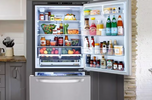
Digital vs Analog Fridge: Which One Should You Choose for Your Kitchen in Singapore?
7 min reading time

7 min reading time
Shopping for a new fridge? You’ll often see one big decision on the spec sheet: digital vs analog control. But what does this mean, and which type is better for you? Let’s explore the differences and help you make the right choice for your home in Singapore.

Analog fridges use mechanical thermostats with simple dials or sliders to adjust the temperature. You’ll usually see:
✅ A rotary dial inside the fridge labeled from 1-5 or cold/coldest.
✅ No digital display.
✅ Temperature regulation happens mechanically, not electronically.
✔ Simple to Use
Just turn the dial to your preferred setting. No tech skills required!
✔ Lower Cost
Generally cheaper upfront than digital models.
✔ Durable and Reliable
Fewer electronics mean less chance of digital failures.
✔ Easy Repairs
Parts and servicing tend to be less expensive.
✘ Less Precise Temperature Control
You can’t set exact temperatures.
✘ No Modern Features
No digital display, alarms, or smart connectivity.
✘ Energy Use May Be Higher
Less efficient cooling compared to modern digital systems.

Digital fridges feature electronic control panels—often touch-sensitive—that let you:
✅ See the exact temperature in °C.
✅ Adjust compartments separately (e.g. fridge vs freezer).
✅ Use special modes like Fast Cool, Holiday, or Eco.
✅ Get alarms for open doors or malfunctions.
✅ Connect to smart home systems in higher-end models.
✔ Precise Temperature Control
Set your fridge to, say, exactly 3°C instead of guessing.
✔ Energy Efficiency
Digital systems optimise compressor cycles to save electricity.
✔ Modern Features
Enjoy extras like ice makers, smart connectivity, and quick freeze functions.
✔ Better Food Preservation
Stable temperatures help keep food fresh longer.
✘ Higher Price
Digital models usually cost more upfront.
✘ Complex Repairs
Digital components can be pricier and require specialised technicians.
✘ Slightly Higher Risk of Electronic Failures
Like any electronic appliance, digital systems can sometimes glitch.
| Feature | Analog Fridge | Digital Fridge |
|---|---|---|
| Temperature Control | Dial-based, approximate | Precise digital settings |
| Cost | Generally lower | Higher upfront cost |
| Energy Efficiency | Moderate | More efficient |
| Features | Basic cooling | Extra functions & smart features |
| Repairs | Simple, low cost | Complex, higher cost |
Here’s how to decide:
✅ Choose Analog If:
You want a budget-friendly fridge.
You prefer simple, no-fuss operation.
Your kitchen space is small (e.g. HDB studio flats).
✅ Choose Digital If:
You want precise temperature control.
You store delicate or expensive food items (like seafood or premium cuts).
You’re upgrading to a modern kitchen with smart appliances.
You prioritise energy savings for your electricity bill in Singapore’s hot climate.
Analog Example:
Electrolux ETB2302H-A 230L Top Freezer Fridge – Simple dial controls, reliable, budget-friendly.
Digital Example:
Samsung 615L Inverter Compressor AI Side by Side Refrigerator (Black DOI) – Digital display, precise temperature zones, energy-efficient.
Both analog and digital fridges have their place in Singaporean homes. If you’re looking for simplicity and low cost, an analog fridge may be perfect. But if you love high-tech features, energy savings, and precise control, a digital fridge could be worth the extra investment.